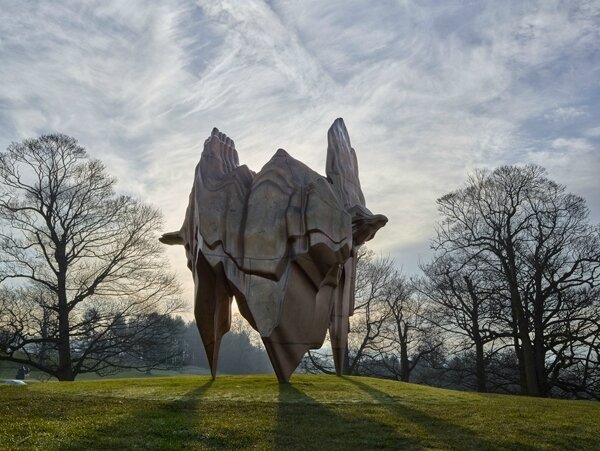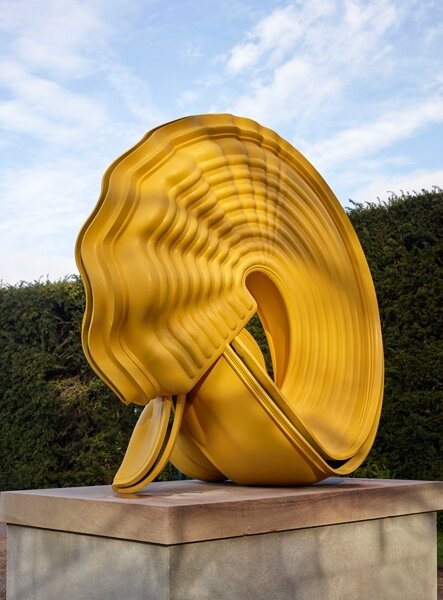Yorkshire Sculpture Park opens most extensive UK exhibition to date by leading sculptor Tony Cragg
Tony Cragg, Caldera, 2008. Bronze, 480 x 372 x 342cm. Courtesy the artist and Yorkshire Sculpture Park. Photo © Michael Richter.
WAKEFIELD.- Yorkshire Sculpture Park presents the most extensive UK exhibition to date by leading sculptor Tony Cragg in the Underground Gallery and open air. New sculptures, works on paper and pieces drawn from nearly five decades of Cragg’s practice will survey and demonstrate the artist’s pioneering and continued mastery of materials.
A ‘radical materialist’, Cragg defines sculpture as a ‘rare category of objects’, and takes a taxonomic approach to his own practice, something reflected in the exhibition. The wit and will to analyse the properties of all of the planet’s resources and use them to make new things is unique to human beings, along with the intuition to sort, order and categorise the things that exist and that we bring into existence. The exhibition begins at the entrance to the Park with the magnificent bronze sculpture Caldera (2008), nearly five metres in height and set against the extraordinary landscape setting of the Bretton Estate.
Tony Cragg, Caldera, 2008. Courtesy the artist and Yorkshire Sculpture Park. Photo © Michael Richter.
Cragg’s extraordinary career has its roots in a fascination for, and exploration of, the possibilities of the material world, which he considers to be ‘the huge storeroom [in which] lie the keys to essential processes and explanations of our existence’. Cragg’s artistic practice developed from drawings he made to document experiments whilst working as a lab technician at the National Rubber Producers Research Association (1966–68). He went on to study at London’s Wimbledon School of Art and the Royal College of Art and during two summer vacations worked nightshifts in a foundry that manufactured components for engines. The combination of art and the experience of the physical transformation of materials through industrial processes is the cornerstone of Cragg’s practice.
His is a systematic approach but, as is exemplified in his major series Rational Beings, which is substantially represented in this exhibition, it is one that acknowledges the alchemical transformation of particular configurations of materials into objects with meaning beyond the sum of their parts. On a material level, for example, the human body is just a unique and fleeting combination of particular atoms from the universe. The artist believes that ‘it could be said that the most fantastic material is the human neuron’, leading Cragg to consider his sculptures as being ideas made manifest.
Tony Cragg, A Rare Category of Objects (installation view). Courtesy the artist and Yorkshire Sculpture Park. Photo © Michael Richter.
Cragg’s extraordinary career has its roots in a fascination for, and exploration of, the possibilities of the material world, which he considers to be ‘the huge storeroom [in which] lie the keys to essential processes and explanations of our existence’. Cragg’s artistic practice developed from drawings he made to document experiments whilst working as a lab technician at the National Rubber Producers Research Association (1966–68). He went on to study at London’s Wimbledon School of Art and the Royal College of Art and during two summer vacations worked nightshifts in a foundry that manufactured components for engines. The combination of art and the experience of the physical transformation of materials through industrial processes is the cornerstone of Cragg’s practice.
His is a systematic approach but, as is exemplified in his major series Rational Beings, which is substantially represented in this exhibition, it is one that acknowledges the alchemical transformation of particular configurations of materials into objects with meaning beyond the sum of their parts. On a material level, for example, the human body is just a unique and fleeting combination of particular atoms from the universe. The artist believes that ‘it could be said that the most fantastic material is the human neuron’, leading Cragg to consider his sculptures as being ideas made manifest.
Tony Cragg, Caught Dreaming, 2006. Courtesy the artist and Yorkshire Sculpture Park. Photo © Michael Richter.
From the small scale to the monumental, Cragg’s prolific practice is the outcome of a constantly questioning and experimental symbiotic process of thought and manual making, which always starts with drawing. This relationship is articulated in the Underground Gallery through a selection of drawings and sculpture alongside each other, allowing visitors to trace the development of ideas into physical form.
With the support of his studio, Cragg makes his sculptures by hand, each evolution of thought inspiring the next. His intuition to sort and categorise, evident in his childhood fossil collection, is expressed in the significant early stacked series in which the accumulated content of his studio, including stones, wood, and books, are formed into geological-like sculptures. This important strand of his practice is shared through the extraordinary sculpture Minster (1990), which greets visitors in the first space of the Underground Gallery. This leads to the previously unseen work in white stone Accurate Figure (2011), which, set against the magnificent gallery windows with historic yew hedge beyond, makes permeable the experience of indoors and out. This dialogue is further explored through the series of Hedge sculptures in the first gallery, considered in relation to key works in the open air such as Early Forms (2001). Further major sculptures in the open air include McCormack (2007) named after the artist’s long-time assistant and Outspan (2008).
Tony Cragg, Outspan, 2008. Courtesy the artist and Yorkshire Sculpture Park. Photo © Michael Richter.
In the Underground Gallery centre space important early and mid-career sculptures, such as Secretions (1998), are shown alongside recent pieces that continue to push the possibilities of both maker and material including the exquisite Group (2012), which is created out of many layers of wood. The third gallery of smaller-scale works draws the eye to consider the close and remarkable details of surface and medium. The entire gallery presents a summation of Cragg’s important career and demonstrates that he is an artist in full command of his chosen discipline. It is given further life through the Project Space, which for the first time shares a breath-taking and inspirational insight into the artist’s studio through the generous loan of personal materials, given context through a chronological overview of the development of Cragg’s practice.
In YSP’s 40th year, the exhibition offers not only the opportunity to experience the work of one of the world’s leading artists, but reinforces the life-affirming capacity of humanity to create. As Cragg himself believes ‘go into a museum and you will automatically be confronted with a whole category of objects that are all, every single one, because of the concentration and the commitment of the individuals that have stood behind them and made them, fighting against mediocrity.’
Cragg’s open and contagious fascination for the universe will inform YSP’s associated learning programme and offer, making links to the National Arts Education Archive which is based at the Park. A limited edition and exclusive exhibition merchandise will be available to purchase along with a full colour publication sharing unique insights into Cragg’s career from both an art historical and philosophical perspective, with texts by Dr Jon Wood (Henry Moore Institute) and Dr Rowan Bailey (The University of Huddersfield).
Tony Cragg, Points of View, 2013. Courtesy the artist and Yorkshire Sculpture Park. Photo © Michael Richter.
Tony Cragg, Sail, 2016. Courtesy the artist and Yorkshire Sculpture Park. Photo © Michael Richter.
Tony Cragg, Willow, 2014. Courtesy the artist and Yorkshire Sculpture Park. Photo © Michael Richter.

/https%3A%2F%2Fprofilepics.canalblog.com%2Fprofilepics%2F1%2F0%2F100183.jpg)
/https%3A%2F%2Fstorage.canalblog.com%2F03%2F02%2F119589%2F96711876_o.jpg)
/https%3A%2F%2Fstorage.canalblog.com%2F11%2F31%2F119589%2F94773502_o.jpg)
/https%3A%2F%2Fstorage.canalblog.com%2F20%2F83%2F119589%2F94772815_o.jpg)
/https%3A%2F%2Fstorage.canalblog.com%2F26%2F72%2F119589%2F75604929_o.jpg)
/https%3A%2F%2Fstorage.canalblog.com%2F59%2F60%2F119589%2F26458628_o.jpg)










/image%2F1371349%2F20240426%2Fob_dcd32f_telechargement-32.jpg)
/image%2F1371349%2F20240426%2Fob_0d4ec9_telechargement-27.jpg)
/image%2F1371349%2F20240426%2Fob_fa9acd_telechargement-23.jpg)
/image%2F1371349%2F20240426%2Fob_9bd94f_440340918-1658263111610368-58180761217.jpg)